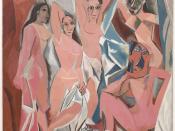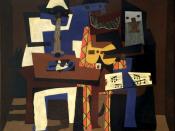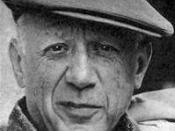Synthetic Cubism Cubism is the parent of all abstract art.
Cubism was created in Paris, France by famous artists Pablo Picasso and Georges Braque in 1907 , the two most influentential artists of this period. Braque and Picasso met in 1907 and have worked very closely in the years since. Braque once said they were like mountaineers roped together.
The Cubist style emphasized the flat, two-dimensional surface of the picture plane, rejecting the traditional techniques of perspective, foreshortening, modeling, and chiaroscuro. The objects were broken up the realized in an abstract form. To the cubist the painting was a flat object in its own right and not a representative of the real world trough a window. One idea behind cubism is to allow the viewer to see all sides of the object from a single vantage point. An example might be a bottle where the mouth is painted from the top view but the rest of the bottle is painted from the side.
Cubism is of major significance because it revolutionized art by showing objects reduced to their geometric forms and introduced a new concept of space.
Cubism was completely new and unimitative. Cubism had an impact on art in general that extended far beyond the existence of the painting style itself; it paved the way for other art revolutions, such as Dada and surrealism, and was seminal to much of abstract art. Picasso and Braque found the precedents and initial concepts for cubism in two art sources. One was primitive art -- African tribal masks, Iberian sculpture, and Egyptian bas-reliefs. The other influence was the work of Paul Cézanne, especially his late still lifes and landscapes. Cubism is a term that was created by Louis Vauxcelles in 1909, after a discussion with Henri Matisse about a work that Braque...


